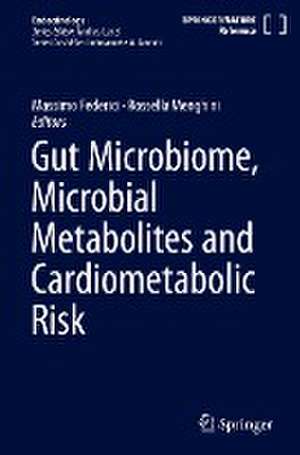Gut Microbiome, Microbial Metabolites and Cardiometabolic Risk: Endocrinology
Editat de Massimo Federici, Rossella Menghinien Limba Engleză Hardback – 2 feb 2024
Written by renown experts in the field,this reference work is intended for clinicians, residents, specialists and physicians involved in the diagnosis and treatment of affected patients.
It is published as part of the SpringerReference program, which provides access to live editions constantly updated through a dynamic peer-review publishing process.
Preț: 2225.75 lei
Preț vechi: 2342.90 lei
-5% Nou
Puncte Express: 3339
Preț estimativ în valută:
426.03€ • 462.92$ • 358.10£
426.03€ • 462.92$ • 358.10£
Carte tipărită la comandă
Livrare economică 16-22 aprilie
Preluare comenzi: 021 569.72.76
Specificații
ISBN-13: 9783031350634
ISBN-10: 3031350634
Pagini: 504
Ilustrații: XVIII, 504 p. 45 illus. in color.
Dimensiuni: 155 x 235 mm
Ediția:1st ed. 2024
Editura: Springer International Publishing
Colecția Springer
Seria Endocrinology
Locul publicării:Cham, Switzerland
ISBN-10: 3031350634
Pagini: 504
Ilustrații: XVIII, 504 p. 45 illus. in color.
Dimensiuni: 155 x 235 mm
Ediția:1st ed. 2024
Editura: Springer International Publishing
Colecția Springer
Seria Endocrinology
Locul publicării:Cham, Switzerland
Cuprins
Methods To Study Metagenomics.- Methods To Study Metabolomics.- Gut Microbiome And Microbial Metabolites.- The Leaky Gut Hypothesis.- Gut Microbiome And Tissue Signature.- Gut Microbiome And Obesity.- Gut Microbiome And Brown Adipose Tissue.- Gut Microbiome And Hepatic Steatosis.- Gut Microbiome And Type 2 Diabetes.- Gut Microbiome And Hypertension.- Gut Microbiome And Dyslipidemia.- Gut Microbiome And Atherosclerosis.- Gut Microbiome And Heart Failure.- Gut Microbiome And Stroke.- Gut Microbiome And Cognitive Functions.- The Other Microbiome: Oral Microbiota And Cardiometabolic Risk.- Prebiotics And Probiotics To Treat Cardiometabolic Risk.- Nutrients, Intestinal Inflammation And Gut Microbiome.
Notă biografică
Massimo Federici is currently Professor of Internal Medicine at the University of Rome “Tor Vergata” Medical School and Director of the Center for Atherosclerosis at the Tor Vergata Medical School hospital. He trained in Endocrinology and Metabolism at the University of Rome (1999) and at the Joslin Diabetes Center (1997). Since 1999, he is actively working in both clinical and molecular research. His laboratory is focused on mechanisms causing diabetes and atherosclerosis, including the effect of gut microbiota on both diseases. He is a member of the EU-funded Florinash Consortium which is studying how the gut microbiome influences the onset and progression of metabolic dysfunction-associated steatotic liver disease (MASLD), Type 2 diabetes, and atherosclerosis in people living with obesity.
Rossella Menghini is currently Associate Professor of Clinical Biochemistry at the Department of Systems Medicine, University of Rome Tor Vergata. After a Chemistry Bachelor Degree (1996), she has been Research Fellow at the Department of Cell and Developmental Biology of the “Sapienza” University of Rome, where she obtained a Board Certification in Chemical Science. She has been Visiting Scientist at the Department of Cellular Microbiology and Immunology of the Vienna Biocentrum, Austria. In 2003, she obtained the Ph.D. degree in Experimental Physiopathology at the University of Rome Tor Vergata, where from 2003 to 2007 she worked as Postdoctoral Researcher at the Molecular Medicine Laboratory Department of Internal Medicine. The research carried out in recent years has focused on the study of the mechanisms involved in metabolic and cardiovascular pathologies, with particular emphasis to the identification of molecular mediators and biomarkers of endothelial dysfunction, atherosclerosis, and obesity-induced adipose tissue inflammation.
Caracteristici
Discusses the relationship between gut alterations and/or gut microbiome-derived metabolites Includes recent advances in clinical applications of microbiome and microbial effector molecules Includes continuous updates on SpringerReference.com














